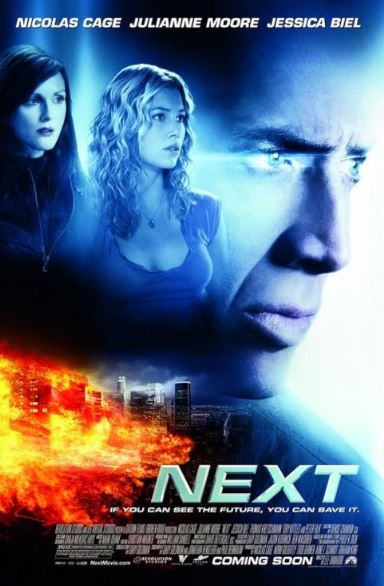In the movie Next (2007), the protagonist, Cris Johnson (played by Nicolas Cage), appears to be an ordinary man living a simple life as a magician in a Las Vegas hotel. However, he possesses the extraordinary ability to see two minutes into his own future. After witnessing his powers during a gunman incident at a casino, FBI agent Callie Ferris (played by Julianne Moore) becomes convinced of his abilities. When the FBI receives information about a nuclear bomb being planted in LA, Ferris believes Cris is the only one who can prevent the catastrophe. The FBI persuades him to sacrifice his freedom for the safety of eight million people, leading to a chase where Cris, advocating for his personal freedom, is pursued. Next can be summarized as a mind game between the FBI, Cris, and terrorists, with a nuclear bomb at the center. But despite his ability to see the future, Cris ends the movie with a reflective monologue:
“Here is the thing about the future. Every time you look at, it changes, because you looked at it, and that changes everything else.”
The poster for Next promotes the idea that “If you can see the future two minutes ahead, you can change the world.” However, the truth is not about changing the world but rather that the world changes on its own. If we glimpse the future, it is no longer the future. As Cris in Next notes, the moment we see the future, it changes. At least, according to quantum mechanics, a branch of physics, this is the case. The Heisenberg Uncertainty Principle explains that the act of observation itself influences the observed object. We perceive objects by the principle that light reflecting off them returns to our eyes. Light is also a particle, and when this particle collides with the object of observation, it affects it, albeit very slightly. When it comes to the size of an electron, as discussed in quantum mechanics, this influence can be significant enough to cause change. Under such circumstances, no matter how precise the physical laws are, it is impossible to predict the future with perfect accuracy. The best we can do is predict within a certain probability range. Although Cris, the protagonist of Next, is a fictional character with the special ability to see the future, even he acknowledges that he sometimes “makes mistakes” (Something’s wrong! I made a mistake). The future appears to Cris in probabilities, just as it would for anyone else.
The world is complex and inherently ambiguous. Thanks to the brilliant efforts of our ancestors, we know quite a bit about this complex world. We can somewhat explain the movement of the universe, the laws of nature, the flow of history, and economic phenomena of the past and present. However, when it comes to the future, the story changes. Even economics, which has made significant theoretical advances, does not score well in predicting the future. Despite enormous scientific theories, we often make mistakes in predicting the weather. The ambiguity of uncertainty we encounter in the world we live in is mostly created by time. Even if we fully understand everything in the present, we cannot entirely predict the uncertainty of the future. We can only predict it within a certain probability range because variables interact with each other over time and change. Even if we can find a pattern in chaos-like complexity, the world we live in is not so definitive.
Digital refers to a method of processing data using specific discrete values rather than continuous ones. Discrete means non-continuous. For example, our computers generate, process, and store all data as combinations of 0s and 1s. To be precise, digital signals are transmitted by combining two states: the flow of current (1) and the absence of current (0). Expressing all information with just these two combinations may seem impossible at first glance, but only eight bits are needed to use language, numbers, symbols, and more in digital form. Since the 0 and 1 in binary represent one bit, grouping eight bits together allows us to represent 256 (2^8=256) states. In other words, using the 256 combinations from 0000 0000 to 1111 1111, we can represent all human characters and numbers. If it were a 64-bit computer, the number would be 18.44 quintillion, making it capable of doing just about anything, leaving nothing unexpressed.
On the other hand, the signals sent by nature are all in analog form, which means they are continuous. For example, human voices or musical instruments produce continuous waveforms. To convert this into digital, it must be broken down into very small pieces. An analog photograph is one whole image, but a photo taken with a digital camera is made up of many puzzle-like pieces. In other words, to digitize the continuous real world, it must be divided into pieces and moved rapidly. This has become possible thanks to incredibly fast computers. As mentioned, computers not only generate data with 0s and 1s but also think with 0s and 1s. The basic logic of computer thinking consists of “no” (0) and “yes” (1).
However, real-world problems cannot always be answered with just “no” or “yes.” The world is full of phenomena where “both are true and could be possible.” When we consider the uncertainty brought by time, most answers will likely lie somewhere between 0 and 1. Like the old saying, “Every cloud has a silver lining,” what seems good today may turn out differently later. While computers answer with the absolute standards of “no” and “yes,” we always think relatively. In other words, we think in the space between 0 and 1. Considering that nature is analog and everything is relative depending on the observer’s perspective, thinking in the space between 0 and 1 seems reasonable. However, thinking between 0 and 1 is necessary not because it’s the better way, but paradoxically, because it’s the only way.
While analog signals are continuous, digital signals are discontinuous and absolute. Theoretically, continuous signals may represent reality more accurately, but analog reality inherently includes ambiguity. Think about an analog clock. The clock hands may not precisely indicate the exact minutes and seconds, and our perception can also be inaccurate. In contrast, a digital clock displays time discontinuously but always provides an exact figure. Whether it’s “right” or “wrong” is another matter. The reason we adopted digital thinking is because the current we use to express continuous values is extremely unstable. By representing all situations with the two states of current flowing or not flowing, we can obtain absolute answers: “no” (0) or “yes” (1). As a result, while the sense of continuity is diminished, errors are prevented in processes like recording, transmitting, receiving, and reproducing. Conversely, this means that errors can frequently occur in analog.
Similarly, while thinking between 0 and 1 may be realistic, there is always the possibility of errors. The world we face is not only ambiguous, but our cognitive abilities also have limits. Even if we manage to pinpoint a position between 0 and 1 with the help of a computer, the only result is two new points of discontinuity—0 and 1—although the gap has narrowed. For example, let’s assume that the average height of men is 175 cm. If a person with a height of 174.9 cm appears, should we consider this person short, or should we see them as meeting the average height? The computer would immediately answer “short,” but the thoughts of people in the world might differ. It was we who commanded the computer to classify ambiguous world information into 0 and 1 and to think in terms of 0 and 1. Therefore, it’s natural that we can’t be certain that the point provided by the computer is the correct answer. The same goes for mathematical accuracy. There is no perfect way to quantify the world’s problems, which is another reason.
In the end, it is up to us to decide. The right answer may or may not exist somewhere between 0 and 1, but we have no choice but to select a point. Beyond the sciences that provide tools like computers, many other sciences strive to find a more accurate 0 and 1. The natural sciences have narrowed this gap to a relatively small range of probabilities. This means we can easily decide within that margin of error. However, in most cases, the gap between 0 and 1 in the social sciences is so wide that failure and success can alternate even within that range. The purpose of academia is to find the best answers, and scientists always pursue accuracy, but we must also remember that the world of academia is built on numerous assumptions. We strive to acquire the knowledge provided by these scientists in search of answers for living in the world. But of course, such a correct answer does not exist.
In reality, we might have to be content with selecting somewhere between 0 and 1 while giving up on precision. It seems impossible to approach absolute or complete truth. Scientists have come to understand the world better by giving up precision, and entrepreneurs have succeeded in business because they yielded perfection. Imagine if Newton had held onto his laws of motion until Einstein discovered the theory of relativity. If the first computer, ENIAC, had been too large and research had continued until it could shrink to the size of today’s computers, the digital age might not have even begun. When Hyundai’s founder Chung Ju-yung built a shipyard in Ulsan, if he had waited until its completion to take orders, Hyundai Heavy Industries might not exist today, or it might have struggled as a latecomer. For internet companies, perfection could be an even more dangerous obstacle. Many successful internet companies today started without even having a clear profit model.
The research of scholars and the wisdom passed down by the seniors in our world are valuable assets in our lives. But these cannot become the definitive answers. The author of Order Out of Chaos, Prigogine, emphasized that even science must acknowledge ambiguity, saying, “A new rationality is emerging, where science no longer needs to signify certainty, and probability no longer means ignorance.” Moreover, how can we ignore the phenomenon of “chance” in our daily lives? If even the slightest difference exists between the conditions of research and the situations in which our seniors lived and the environment we face, we must make even slight adjustments. While academics may be digital, reality is analog. No matter how well-versed one is in economic theory, they cannot immediately become an expert in economic policy. Just because someone is a master of physics does not mean they can invent something new. Even if we are armed with knowledge, we learn how to make micro-adjustments as we engage in a dialogue with the real world. Nothing is perfect, and there is no single answer. Because we can only choose one point within the range between 0 and 1, what we seek should not be the “correct answer” but the “superior answer.”


답글 남기기